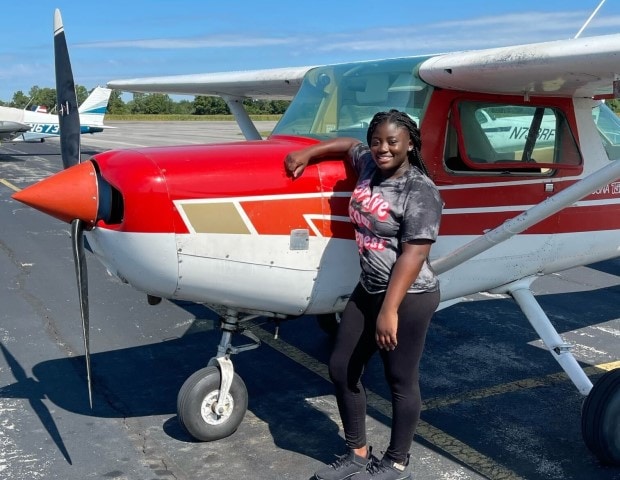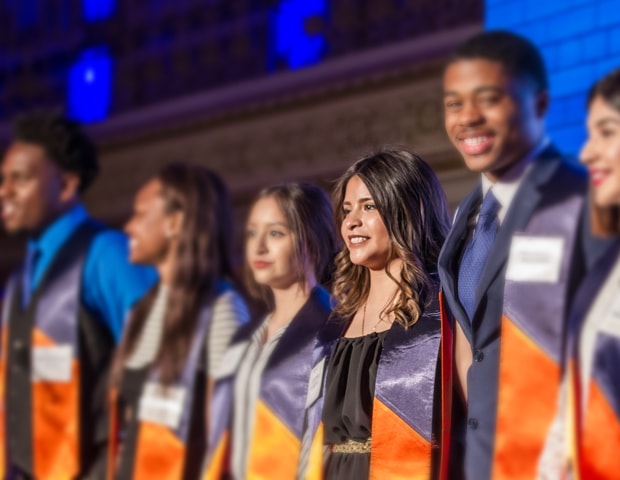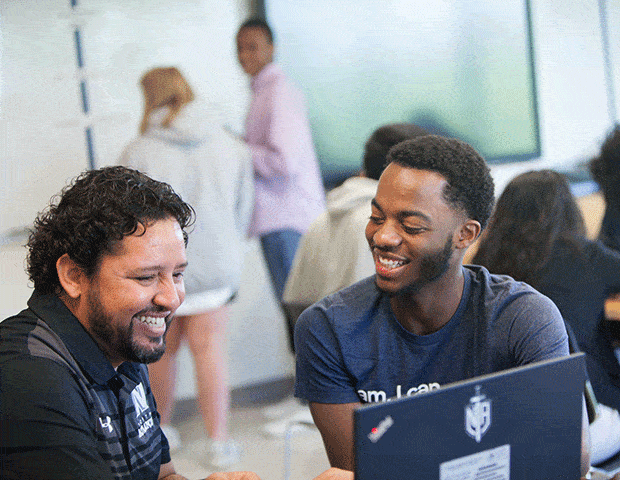Mercy Ajala’s dream of flying has guided her postsecondary journey into aviation school and flight training. With one semester left before earning her Bachelor’s degree, Mercy reflects on her relentless pursuit of becoming a pilot.
A Conversation with Joliet Central High School
By Stephen Barker
January 17, 2023
The OneGoal Leadership Network partnered with Joliet Central High School beginning in 2022 to enhance postsecondary advising and support for students. Joliet Central’s Amanda Ringfelt and Jeffrey Riley reflect on the challenges they worked to address as they built a district-wide vision to ensure all their graduates were prepared and supported to achieve postsecondary success. They were interviewed in late 2022 by OneGoal Director of Communications, Stephen Barker.
Stephen Barker: Can you share a little background about how you got into this work and what you love about working with students?
Amanda Ringfelt: I am a school counselor here at Joliet Central. This is my fifth year as a counselor and before this I was an English teacher at Joliet West for 12 years. As for my journey into education, I decided when I was a Senior in high school that I wanted to be an English teacher. I had a really great English teacher in high school who was also a softball coach for me, and I always felt valued in his class because he saw his students as more than just young people occupying seats; he wanted to have a positive impact on his kids. I loved that through English class, we could have conversations about important issues and explore who we are as people. So, I thought that would be a good fit for me, and it was for a really long time. Working with transfer students to Joliet West, I saw that there were gaps in services for different subgroups. I came to a realization that as an English teacher, my ability to have an impact on those more systemic challenges was limited. So I wanted to shift into a role where I could do more of that work, and that is when I decided to pursue my counseling degree. I was really sad to leave Joliet West because that’s where I spent my whole career. But I am very happy to be here at Central. I think it’s a great fit. We have an amazing team here.
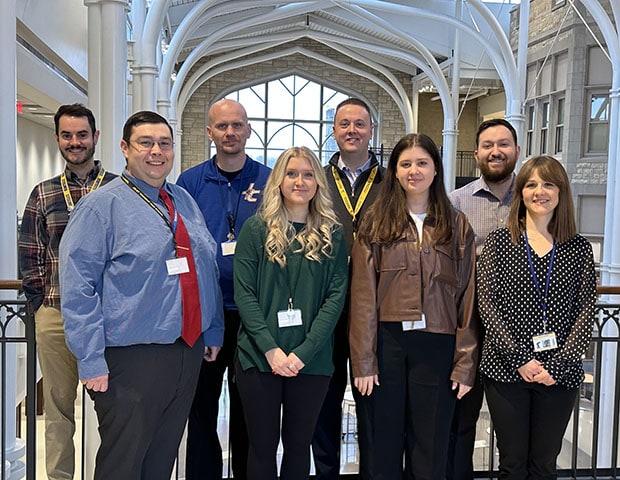
The Joliet Central High School OneGoal team. From left to right: Dave Noftsger (teacher), Brett Marcum (Director of Student Support Services), Nick Zorn (teacher), Amanda Wisslead (teacher), Jeff Riley (Academy Coordinator-11th Grade), Sophie Chaulk (teacher), Joe Fekech (teacher), Amanda Ringfelt (counselor).
Stephen: Thank you for sharing that. Can you say more about your counseling team and how it’s structured in the district?
Amanda: There are ten of us and we all share the student caseload. From a shared office space in the building, each of us serves grades 9-12, working side-by-side. Each grade level is assigned leads for different groups; so for example, I’m one of the lead counselors for grade 11, along with two of my colleagues. Even though we have students from each grade level, different team members are in charge of developing the curriculum for different grade levels, creating presentations and lessons, and pushing those things out. But all ten of us share the load. A couple of weeks ago, we gave presentations in all the US history classes on postsecondary programming research. So me and my counterparts created the lesson, and all ten of us divided up all the US history classes and went in and delivered those lessons. All of us work closely with a dean and social workers, meeting weekly about students on our caseload that we want to support beyond the level of support that we as guidance counselors have for all of our kids.
Stephen: Thanks, Amanda! Passing it off to Jeffrey. Can you tell us about yourself and your work?
Jeffrey Riley: Sure! I’m the Academy Coordinator for our 11th grade team, which is comprised of all of our teachers that teach our 11th grade core area subjects, along with our career and technical education teachers. At Joliet Central High School, we’re 3300 Students strong, and located in the southwest suburbs of Chicago. The first thing you would notice about Joliet Central if you visited would be that we all work every day inside a castle. No really! It’s a 120-year-old, beautiful limestone castle on the National Register of Historic Places. It’s hard not to feel the magic of this place from the beautiful campus that we work in each day. Before becoming an administrator, I was a business ed teacher, teaching marketing, accounting, and computer classes, which I loved. I come from a family of educators. And working with the students at Joliet Central, it’s hard not to love what you do coming to work each day with the opportunity to really make an impact on students’ lives. So I couldn’t imagine working anywhere else because we have really great and talented people who are passionate about this work. Amanda is a great example of that. She is so dedicated to his work, and helps us understand where we need to go, and then we go out and we do it. The decision to partner with OneGoal is a great example of that leadership as a way of achieving our postsecondary goals.
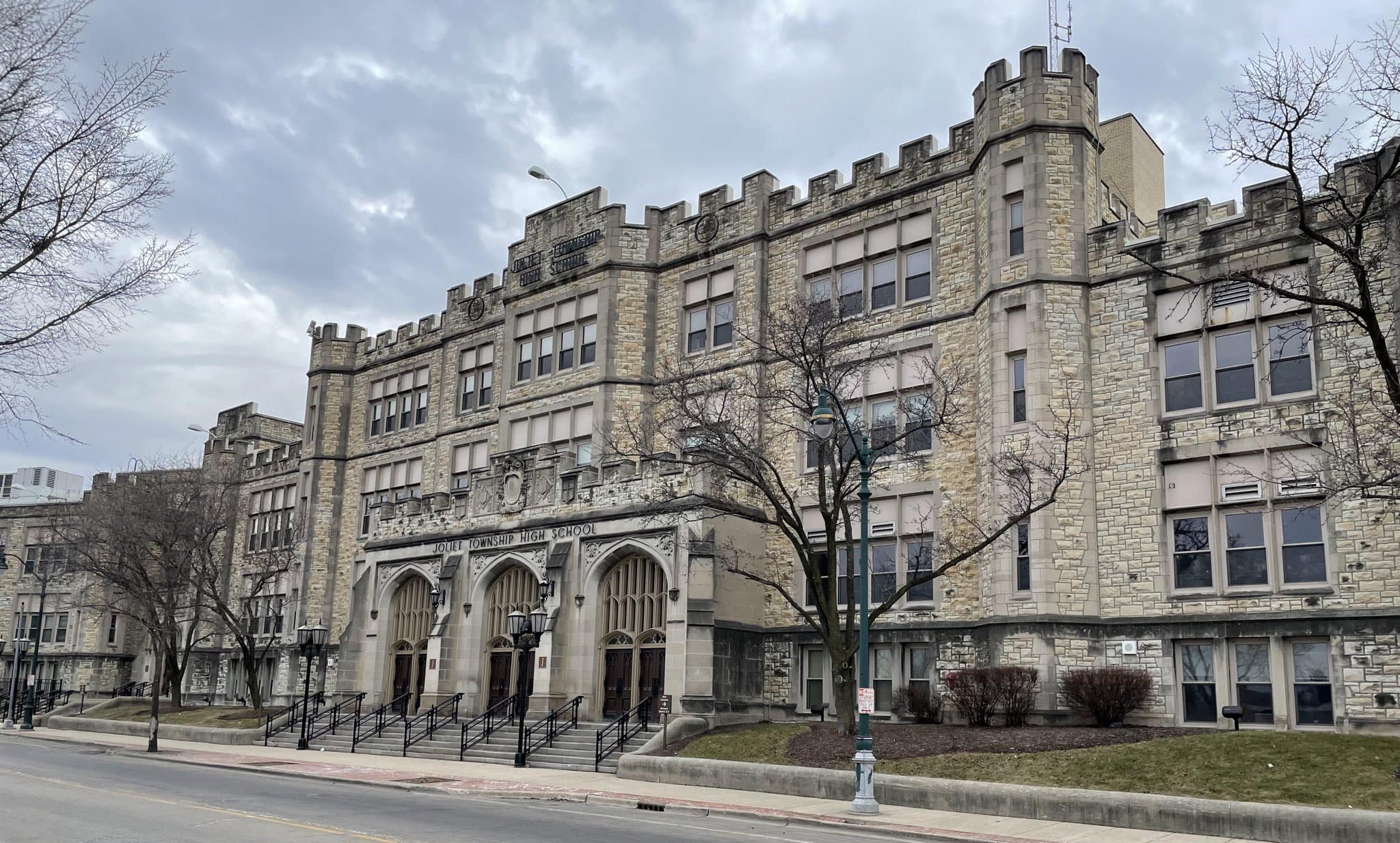
Joliet Central High School, located in Chicago's Southwest suburbs, is known for it's striking façade reminiscent of a medieval castle. The 120-year-old structure is on the National Registry of Historic Places.
Stephen: Take us through how the two of you work together. Where are their intersections and how does your work align?
Amanda: Being one of the 11th grade leads, my role falls under Jeff’s leadership. He acts as a conduit between my team and the classrooms. So for example, he was instrumental in helping me connect with US history teachers to push that lesson I mentioned earlier out to students. We’re in the process of disseminating new lessons to students next week, and I will rely on Jeff to make things happen and put things in motion for our classroom work. He was also a groomsman in my wedding, so we have that going for us too!
Stephen: Wow! You must go way back then?
Amanda: We do!
Stephen: Let’s jump into the postsecondary work you mentioned, Jeff. What led to the district’s decision to partner with OneGoal?
Amanda: Brett Marcum, Joliet Central’s Director of Student Support Services, brought OneGoal to our instructional leadership team for counseling. He let us know about the opportunity to partner with OneGoal through the Illinois State Board of Education, and as a team, we were really excited by that immediately. We wanted access to the OneGoal curriculum as quickly as we could because we felt that it would help to close the college access gap, which we definitely see with our students. We have a lot of first-generation college students and students of color that are traditionally underrepresented in postsecondary higher education. We wanted to make sure that we gave everybody the level of attention and support that they needed for them to identify a postsecondary plan that was a good fit for them and that they had the tools to enact that plan. We saw OneGoal as a way to make that happen.
Stephen: You touched on this, Amanda, but I’d love to get a bit more granular in terms of specific goals that you had in mind around creating a more equitable system for postsecondary advising and preparation.
Amanda: Closing that college access gap within Joliet Township is our northstar. We developed a comprehensive counseling curriculum a few years ago, and we are roughly into year three of our implementation. Our instructional leadership team met over the summer to develop and refine that curriculum, and we saw OneGoal as another piece to help strengthen it. We recognize that we have a lot of students that need more support to make their postsecondary plans. Ensuring that all of our students have the support they need in creating a plan and having the tools to make that plan a reality is likely to become part of our upcoming strategic plan for the next five years, and OneGoal is going to be instrumental in helping us achieve that for all students.
Stephen: Are there roadblocks or challenges unique to first-generation and underrepresented minority students at Joliet Central that you and your team identified?
Amanda: I think the main challenge is in navigating the financial aid process. Having the information they need to make informed decisions about how to finance a postsecondary education and then making choices that are realistic, while also knowing where to find financial aid to open up opportunities is the biggest piece. That’s where OneGoal has already helped, that and the career exploration piece. That’s something we are always trying to improve is how we are helping students connect with careers that are a good fit for them; challenging the belief we have that everybody should go to college, even if their path doesn’t require it. We’ve catered more to the college-going group, and OneGoal allows us to think more comprehensively about our students. We need to find a way to reach all of our students, regardless of where their postsecondary pathway might lead, give them a framework for exploring what those paths are, and how to create an action plan for their life after high school, especially how to pay for it.
Stephen: I’d like to pivot to your work with your OneGoal Leadership Coach, Michael Allen. All of the schools we partner with are paired with an experienced coach like Michael, and I’d love to hear how Michael is helping your team identify strategies to overcome the challenges your students face.
Amanda: Yeah, Michael has been awesome. He came to our building a couple of weeks ago for a meeting with me, Jeff, Brett and our five OneGoal teachers. He came to check in with us and see where everyone was; what’s working for them and what’s not. He sort of gave us permission to make adjustments to fit our plan for implementing OneGoal for our students and our teachers, and that has been very liberating for us. He’s allowing us to work things out as we need to and giving us permission to do things that work in the context of our school, without making us feel like we’re failing because things aren’t going exactly the way we initially planned.
Jeffrey: One thing I really like about Michael too are his fresh set of eyes on the things; he has a great perspective. Sometimes we operate in an echo chamber, but Michael always has valuable insights through his work with multiple districts. His encouragement always gives us a boost too. There were times Amanda and I were like, are we on the right track? And Michael would stop us and say hey! You guys are doing great, what are you talking about? You’re head and shoulders above where we thought you’d be at this point. So while he’s been such a valuable resource because of his knowledge, he’s also been a cheerleader for us as well too, which, when you’re implementing something like this, you can’t undervalue that aspect of it as well.
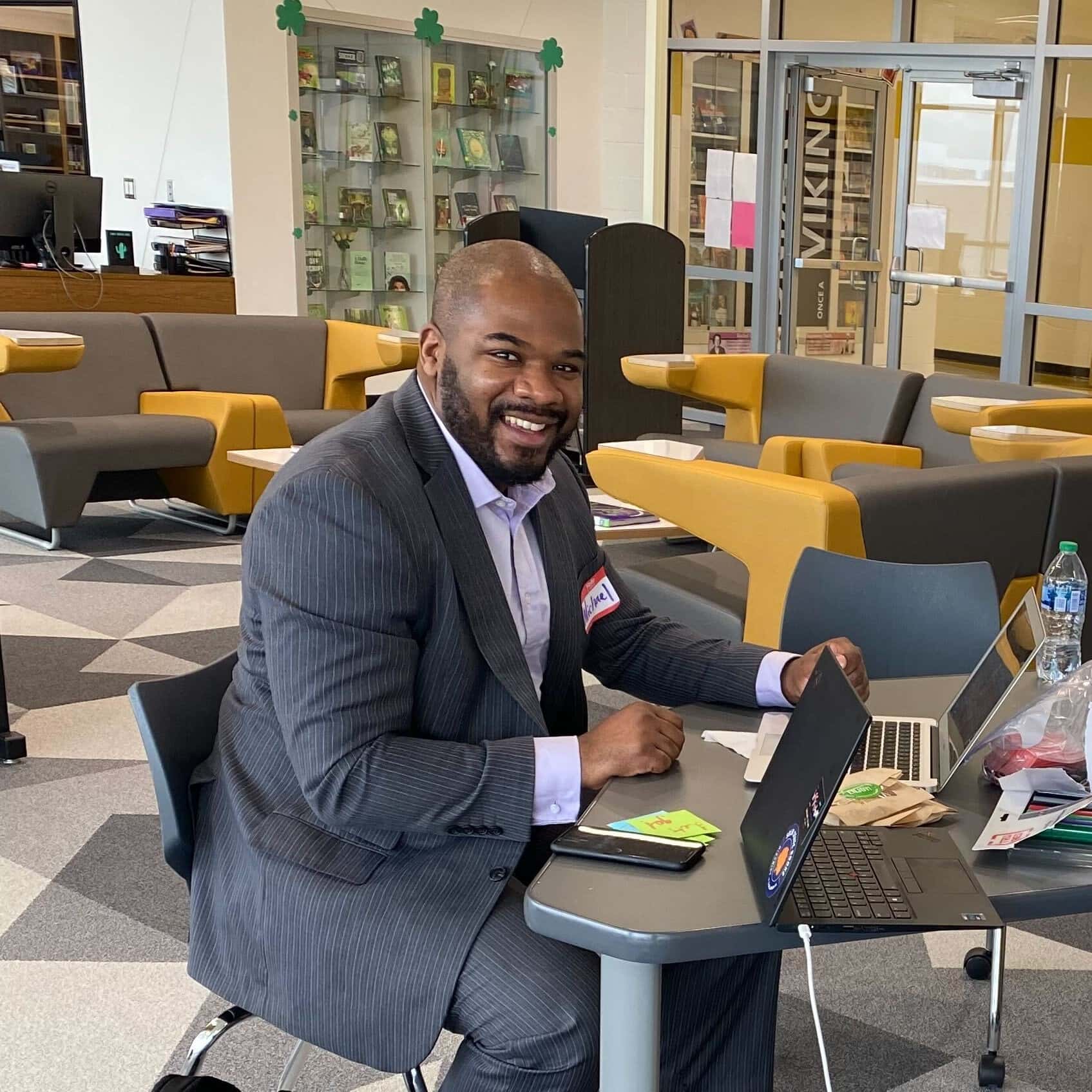
As a partner district, Joliet Central works closely with OneGoal Leadership Coach Michael Allen, who guides their team every step of the way on a path to improvement that’s tailored to their unique needs.
Stephen: I love that! I’m also really interested in time and capacity. Right now, there’s a narrative about what’s happening on the ground in schools around staff shortages, learning loss, and other major challenges, which are very real. But given these present challenges, why did you feel it was important to also focus on the barriers to postsecondary for your students?
Amanda: From a counseling perspective, I have over 300 students on my caseload, and about 70 seniors. So we’re trying to meet with those kids individually to give them the full amount of support that they need and it’s next to impossible, right? I’ll meet with one student who has already started the process with their family, which is great. But that’s maybe five kids out of 70. So I think what we are finding is that preparing kids for lives after high school has to be a shared initiative. Everybody in the building has a part to play in that. From the moment they walk in the doors as freshmen, we want students to understand that graduating from high school is not the end goal. High school is the vehicle to get to wherever it is you want to go in life. OneGoal will be a big piece of achieving that vision for us in thinking more creatively about how we can build postsecondary preparedness into every facet of the student experience. From the sports they play, the classes and electives they take, the relationships they have with their families and peers, and even field trips, we’re asking, ‘how do we infuse postsecondary preparation into every minute of your day here?’
Jeffrey: You bring up a good point about capacity. As we expand these types of initiatives like OneGoal, the question of how we support our staff in feeling comfortable is central. I don’t think you’d ever find a teacher who would say I don’t think that I play a role in helping students get ready for postsecondary success, but then they’re going to need support and training because it’s still a difficult process for people to navigate, and it is constantly changing.
Amanda: Thankfully for us, the draft of our strategic plan submitted to the board for approval outlines that postsecondary preparation is going to be a priority for us. Our students are going to graduate, go out into the world and into our communities. So what impact are we preparing them to have in their world? If we don’t do our job to prepare them for that and make sure they have a plan to develop the skills, mindsets, and the aptitudes to be successful, then I don’t think we’re doing our job in education.
Jeffrey: She’s right. It’s about taking a step back and asking, ‘what is our purpose here with our students?’ And it’s hard in education to stop and reflect on that question because of the hustle and bustle of every day. But for us we said, we’ve got to do this. We’ve got to get them ready and geared towards a goal of postsecondary success. And once we made that decision all those things are naturally falling into place.
Amanda: When students are able to define their purpose, attendance improves and overall engagement improves.
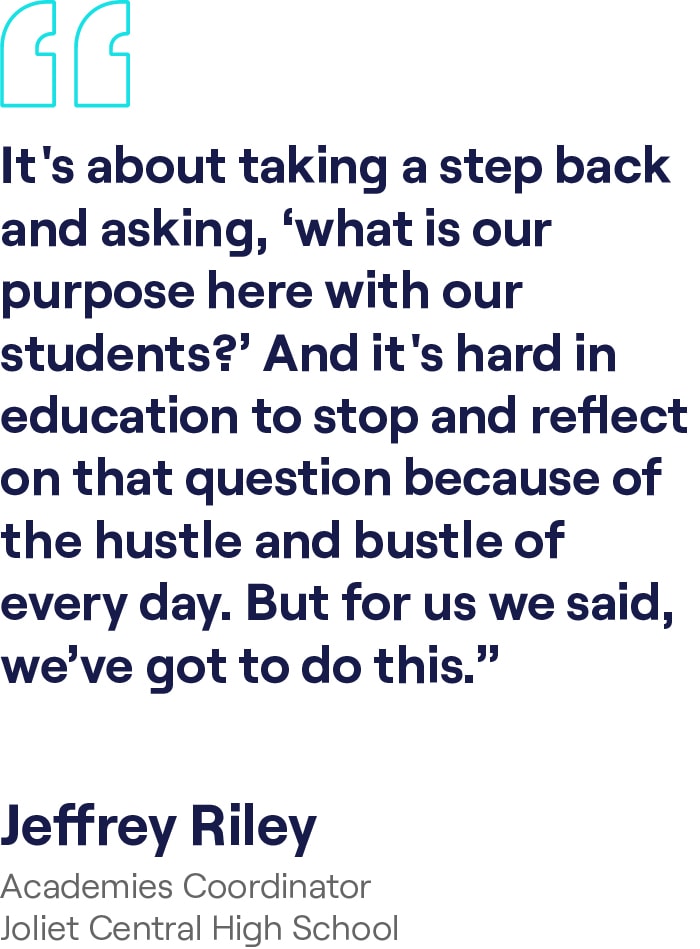
Stephen: You bring up an interesting point, Amanda. What’s it been like for you to observe students being affirmed in their identities and exploring what it is they value in an intentional space?
Amanda: It’s really cool. It’s awesome. When you asked earlier about time and capacity, it made me think about how easy it is to dismiss this work and say we don’t have enough time. It feels like such a big project, so you think maybe we could focus on something easier instead. But then you have these conversations with kids and you see the light bulbs going off, and you start to see the planning happening, and you see them get excited. It starts to become easier to rationalize the investment of time. To see how meaningful it is and how much of an impact it can have for our kids that need it most. It’s invigorating.
Stephen: What advice do you have for people that were in your shoes before you started moving in this direction? Schools that are looking at their student body and thinking about postsecondary enrollment, persistence, and completion and not seeing the outcomes they hope for?
Jeffrey: I really think it’s about empowering the people in your building that are passionate and knowledgeable and ready to drive the train on making those improvements. You have to give those talented individuals the time and the space to run with the things that they know will work for your students. And importantly, connect them with the resources that they need to make it happen. One obvious solution here is OneGoal, which allows them to take their ideas about what their students need and then partner with someone who has the expertise to move the bus forward. When you let the people in your building do what they know is best for students, it’s pretty easy to see results.
Amanda: First I would say just do it. Right? Like take the plunge! That’s what we did, but we also are taking it slow. It’s been helpful to have everything laid out from OneGoal. And like Jeff said, having a solution that’s been vetted that we know works. But then taking ownership of it and making those adjustments that will make it work best for your students and staff, that’s what has made the difference for us this year. In talking with our advisors, they’re ready to keep going with this next semester.
Related Stories
College was never part of Yesenia Garcia’s plan. But joining the OneGoal cohort in her school not only led to achieving a degree, she’s now an advocate for students like her. “OneGoal set a foundation for me. I fell in love with education. I fell in love with equality. It gave me a sense of pride. And it definitely gave me hope, because I remember not having any and when college was not on my radar whatsoever.”
Our District Partnership Program team is experimenting with different implementation structures of our flagship classroom model in partnership with districts, allowing us to reach more students and adapt to schools’ various contexts.
